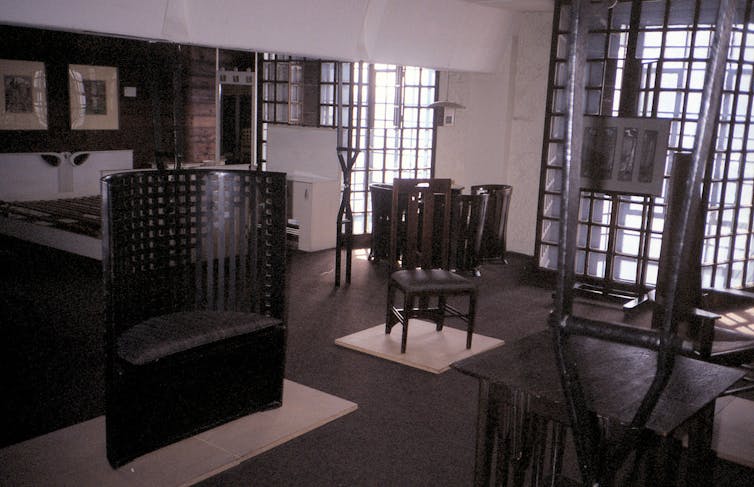world of architecture will rally to save Mackintosh masterpiece
Glasgow School of Art is one of the few buildings that can lay genuine claim to the word “iconic”, not just for the style of architecture it represents, but for the complex symbolism invested in every part of its design by its architect, Charles Rennie Mackintosh. The shock following the fire that has swept through it will be felt way beyond Glasgow, Scotland and the UK; this is a historic building of great international significance.
Begun in 1897 and completed in 1909, the school was constructed in two phases, the east end providing evidence of the influence of the Scottish baronial style on the then 29-year-old architect, while the final version of the north elevation and the west (library) end of the building demonstrated the astonishingly creative and intellectually sophisticated hand of someone who had within the subsequent decade developed into an absolute master of his craft.
That Mackintosh’s outstanding talent was recognised so early by Francis Newbery shows remarkable prescience by the then Head of the School, who somehow managed to structure the competition for the new building’s design to ensure that his young protégé secured his first significant commission. The contract for the project went to Mackintosh’s then employer, the Glasgow practice of Honeyman & Keppie Architects, but there has never been any question as to the identity of the building’s author and indeed the hands-on involvement of its architect throughout the School’s gestation is well documented.
Design challenge
The site of the Glasgow School of Art was undoubtedly a design challenge in itself. Built on the top of Garnethill, the land slopes steeply up from Sauchiehall Street (the street of the sauchies, or willows, and the location for his Willow Tearoom of 1904) to the east-west oriented Renfrew Street.
Mackintosh’s genius was to use the section of this sharply inclined site to advantage, generating a very tall building (9 storeys+) from its lowest point through to what appears as a four storey elevation that manages even in its asymmetry to represent the classic ordering of base, piano nobile (in the tall windows of the north facing studios) and attic storey.

aldisley, CC BY-NC-ND
In doing so he nevertheless eschewed the obvious traditional narrative of columns and capitals, favouring instead the use of the more modern materials of glass and wrought iron to deliver a refined and elegant rhythm of windows along the principal facade of the building. The section, however, is core to the success of the School of Art, not only in the way in which Mackintosh skillfully manipulated the internal walls and ceilings to deliver light into the deepest recesses of each space but in communicating through its central staircase element the Platonic notion of emerging from the cave (basement) into the light (the unique ‘hen-run’ on the roof of the building which appears to have been very badly damaged).
Magical effect
There are many distinctive spaces and architectural triumphs throughout the School of Art but none more so than its library, an extraordinary and absolutely unique conception that draws upon the architect’s own studies of Michaelangelo’s Laurentian Library in Florence for the system of frames and layers used in the articulation of its west window wall to reduce the volume and weight of stone in the exaggerated verticality of its elevation. Mackintosh used this ingenious device to maximize the amount of natural light entering and permeating the forest of black painted timber columns that support the room’s mezzanine level before pushing further upwards to the ceiling.
This effect is made more magical still by the range of colours scalloped into the vertical balusters that ring the room’s upper level. Light reflects off these multi-hued surfaces in much the same way that light dapples through the canopy of a closely planted stand of trees to complete the arbor-like sense of retreat and contemplation the architect intended for this quite extraordinary space.

Dave & Margie Hill / Kleerup, CC BY-NC-SA
But there is so much more to this building than meets the eye on a first visit. As with all great buildings, Glasgow School of Art bears constant investigation, since each repeat visit reveals new and previously unnoticed features. An educational experience in itself – the more you learn from it, the more the building itself seems to live and grow.
Mackintosh produced an architectural masterpiece in this building and it can genuinely be described as a gesamtkunstwerk in which his hand can be seen to have touched – and enlivened – every part to the benefit of the user. At no time did he depart from the brief to create an art school – he just did it with astonishing imagination and panache and in a way that is simply impossible to repeat.
The challenge presented by the horrifying fire that appears to have risen through the building from its lowest levels to the roof is how to fully restore it to daily use and for the purpose for which it was built without introducing all kinds of preventive and intrusive technologies.
Considerable sophistication and subtlety will be required as well as patience and a great deal of money. The building is, however, revered by architects and art lovers around the globe, and they may well be encouraged to support calls for donations. But as has happened with so many damaged projects throughout the world, the biggest problem and source of delay may prove to be the number of Mackintosh “experts” likely to materialise to debate what should be done to repair the building.

